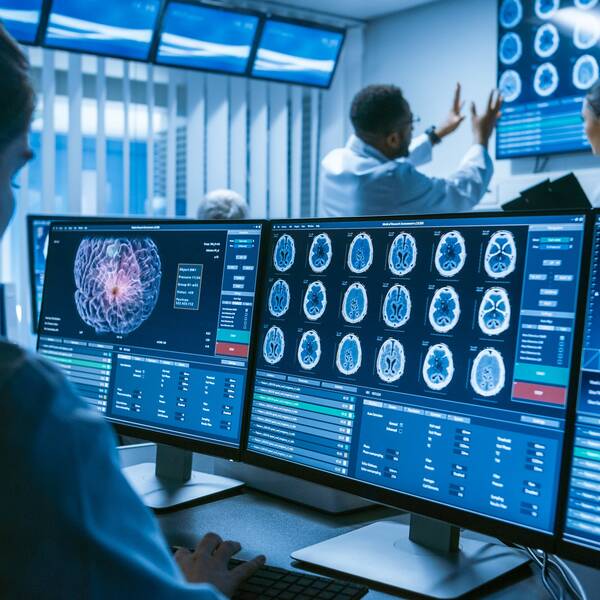
When patient health and safety is at stake, manufacturers of medical products, systems, and devices have to maintain high standards for quality. Industry regulations also require exacting measurement, tracking, and reporting to ensure compliance. Whether evaluating the uniformity of diagnostic display monitors or embedded screens, measuring luminance and CCT of lighting for medical environments, or validating image clarity in AR/VR headsets, developers and manufacturers need metrology solutions they can trust for precise, rapid, and complete quality measurement.
Medical Grade Displays
Display monitors used in medical settings need to offer enhanced performance and greater longevity (due to their constant usage) compared to the typical commercial and consumer displays. Medical displays usually come with special image-enhancing technologies to ensure constant brightness and clear and consistent images over the lifetime of the display. Key considerations for medical displays include resolution (to enable fine-grain image details needed for accurate diagnosis or research, luminance (often referred to as “brightness”), and contrast (many medical images such as X-rays and mammograms are monochromatic.
Medical imaging relies on the “just noticeable differences” (JND) standard first developed by NASA. JND is the smallest difference in luminance (e.g., between two gray levels) that the average observer can just perceive on the display system. Radiant’s ProMetric Imaging Photometers and Colorimeters replicate the visual perception of the human eye, incorporating JND to assess display uniformity. Radiant’s systems offer the high-resolution, precision color and grayscale measurement needed to assess visual quality for monochrome, color, and multi-modal displays. Our display measurement solutions perform at production-line speed, and capture the quantitative data manufacturers need to ensure compliance with industry standards for medical displays.
Augmented & Virtual Reality

VR (virtual reality) AR (augmented reality) and MR (mixed/merged reality) are changing the landscape of medical education, surgery, research, and patient care and treatment. Any visual defects in the headset display or projected images can interfere with performance and diminish clinical effectiveness. In critical situations like a live surgical procedure, even tiny visual imperfections in a headset could have serious consequences.
To help AR/VR headset designers and manufacturers ensure the visual performance of their devices, Radiant Vision Systems offers a range of solutions including our AR/VR Lens and XRE Lens that feature a unique optical design specially engineered for measuring near-eye displays (NEDs), such as those integrated into VR, AR, and mixed reality (MR) headsets. The lens design simulates the size, position, and viewpoint of the human eye to accurately capture and evaluate the wearer’s visual experience. Multiple FOV options are available.
Combined with ProMetric Imaging Photometers and Colorimeters that match human perception of light and color, our solutions enable XR device makers to test products as seen by the user. Radiant’s TT-ARVR Software offers an extensive library of analyses such as MTF, distortion, and ghosting. Additionally, we offer new solutions for accurate and efficient measurement of AR/MR devices and smart glasses that incorporate user-specific prescription optics.

Embedded Medical Device Displays
Clinical Devices. The increasing digitization of medical practice and care management has led to a boom in integrated medical devices. In today’s fast-paced care settings, clinicians must rely on devices such as blood pressure monitors, oximeters, infusion pumps, ventilators, fetal monitoring devices, and ECG machines. The information shown on these device displays has to be clear and readable under bright surgical lights or in a darkened hospital room, and accurate without interference from screen defects. Display devices also must be rugged to withstand daily use, cleaning, and sanitization. These demands require extensive display quality testing and evaluation to ensure performance when patient health and safety is on the line.
Consumer Devices. As consumers have become accustomed to features like touch screens and apps in their everyday devices like cell phones, likewise they expect to find the same convenience and features in the latest medical devices. Bright, high-resolution displays such as OLED are also becoming more common. It can be a challenge for manufacturers to provide this display experience while also meeting the regulatory requirements that apply to medical use devices.
Lighting

Lighting in medical settings serves a wide variety of needs such as bright lighting in clinical treatment rooms, intense task lighting for surgical procedures, comfortable lighting in public spaces and waiting rooms, and nighttime lighting in patient wards to facilitate both sleep and staff activity. Manufacturers of LEDs, luminaires, and lighting fixtures need to measure the output and distribution of their products to ensure correct luminance, CCT, and beam spread. Radiant provides tools for light measurement and characterization including our SIG-400 goniometric system and ProSource software.
Digital Signage
Hospitals and medical facilities are increasingly adding digital signage and displays into their environments to enhance patient communication and streamline operations. Display signage and interactive display kiosks in public areas can offer wayfinding, information, and real-time updates for patients and visitors. E-Paper displays can replace white boards and manual notetaking to improve efficiency and legibility for the patient care team. Behind the scenes, digital signage can improve work processes such inventory management.
Many displays use LCD, LED or OLED technology, and some incorporate touch-screen functionality. Radiant’s decades of experience in visual display inspection helps manufacturers ensure the quality of all types of display, from backlit LCD panels to emissive OLED screens, from navigational signage to large-format displays and video walls.


